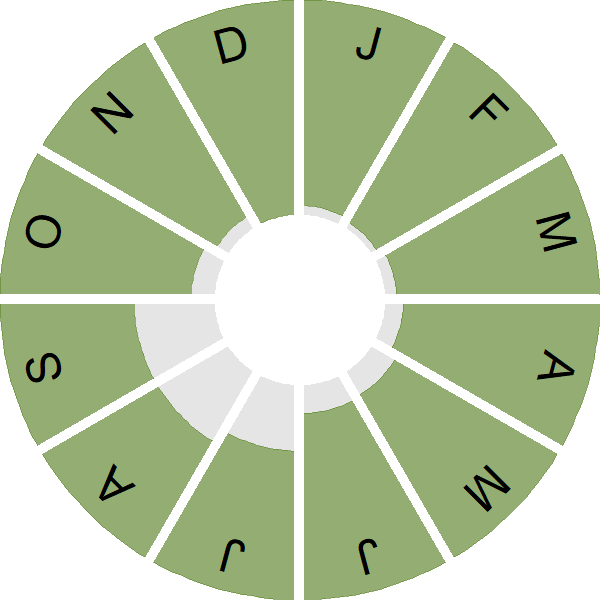Tree Sparrow
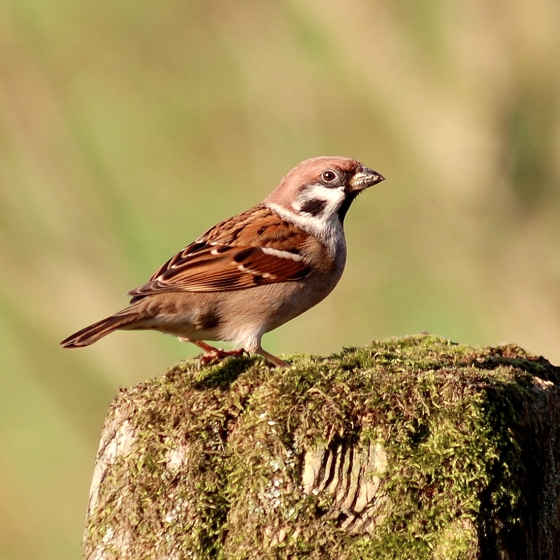
Introduction
Slightly smaller that the much commoner House Sparrow, the Tree Sparrow's chestnut crown and black spot in the white cheek make it easy to identify.
Very much a bird of farmland edge, the UK Tree Sparrow population declined dramatically in the 1980s. Recent data, however, show small signs of recovery, although this species remains on the the UK Red List, where it has been found since 1996.
Tree Sparrows are found primarily in eastern and lowland areas of Britain & Ireland. East Yorkshire is a stronghold for British Tree Sparrows, and they can be locally common during the April to August breeding season. Outside of this time Tree Sparrows can move quite some distance with some breeding areas being vacated altogether. Some of the East Yorkshire birds have been reported during the winter months in Suffolk, heading back north as winter turns to spring. Where breeding, Tree Sparrows can be found in small, loose colonies.
- Our Trends Explorer gives you the latest insight into how this species' population is changing.

Key Stats
Identification
ID Videos
This section features BTO training videos headlining this species, or featuring it as a potential confusion species.
Sparrows
Songs and Calls
Call:
Status and Trends
Conservation Status
Population Change
Tree Sparrow abundance nose-dived spectacularly in the UK between the late 1970s and the early 1990s. BBS data indicate a significant increase since 1995, but it should be remembered that, for every Tree Sparrow today there were perhaps around 20 in the 1970s, and any recovery therefore has a very long way to go. Clear range contractions occurred between the first two breeding atlas periods (Gibbons et al. 1993), and have accelerated subsequently: Tree Sparrows have now withdrawn completely from some southern and western regions of Britain, but conversely have spread in Northern Ireland (Balmer et al. 2013). Following declines across western and northwestern Europe during the 1990s, the European status of this species is no longer considered 'secure' (BirdLife International 2004). There has been a decline across Europe since 1980 (PECBMS: PECBMS 2020a>).
Distribution
Following major changes in distribution since the 1970s, Tree Sparrows are now concentrated in low-lying parts of central and northern England, in eastern Scotland, the Welsh Marches, and around Lough Neagh and in eastern Irish counties. In both seasons, densities are highest in northeast England and Scotland.
Occupied 10-km squares in UK
2007/08–10/11
or view it on Bird Atlas Mapstore.
2008–11
or view it on Bird Atlas Mapstore.
European Distribution Map
Distribution Change
Trends differ markedly across Britain and Ireland. In Ireland there has been a 71% winter range expansion since the 1980s. In contrast, the British range has contracted by 20% in winter since 1981–84 and by 41% in the breeding season since 1968–72. Tree Sparrows have disappeared from much of southeast England, south Wales, the Pennines and the western part of the Central Belt in Scotland. These losses are offset slightly by gains in northeast Scotland.
Change in occupied 10-km squares in the UK
from 1981–84 to 2007–11
or view it on Bird Atlas Mapstore.
from 1968–72 to 2008–11
or view it on Bird Atlas Mapstore.
Seasonality
Tree Sparrow is recorded throughout the year on up to 5% of complete lists.
Weekly pattern of occurrence
The graph shows when the species is present in the UK, with taller bars indicating a higher likelihood of encountering the species in appropriate regions and habitats.

Habitats
Breeding season habitats
Relative frequency by habitat
The graph shows the habitats occupied in the breeding season, with the most utilised habitats shown at the top. Bars of similar size indicate the species is equally likely to be recorded in those habitats.
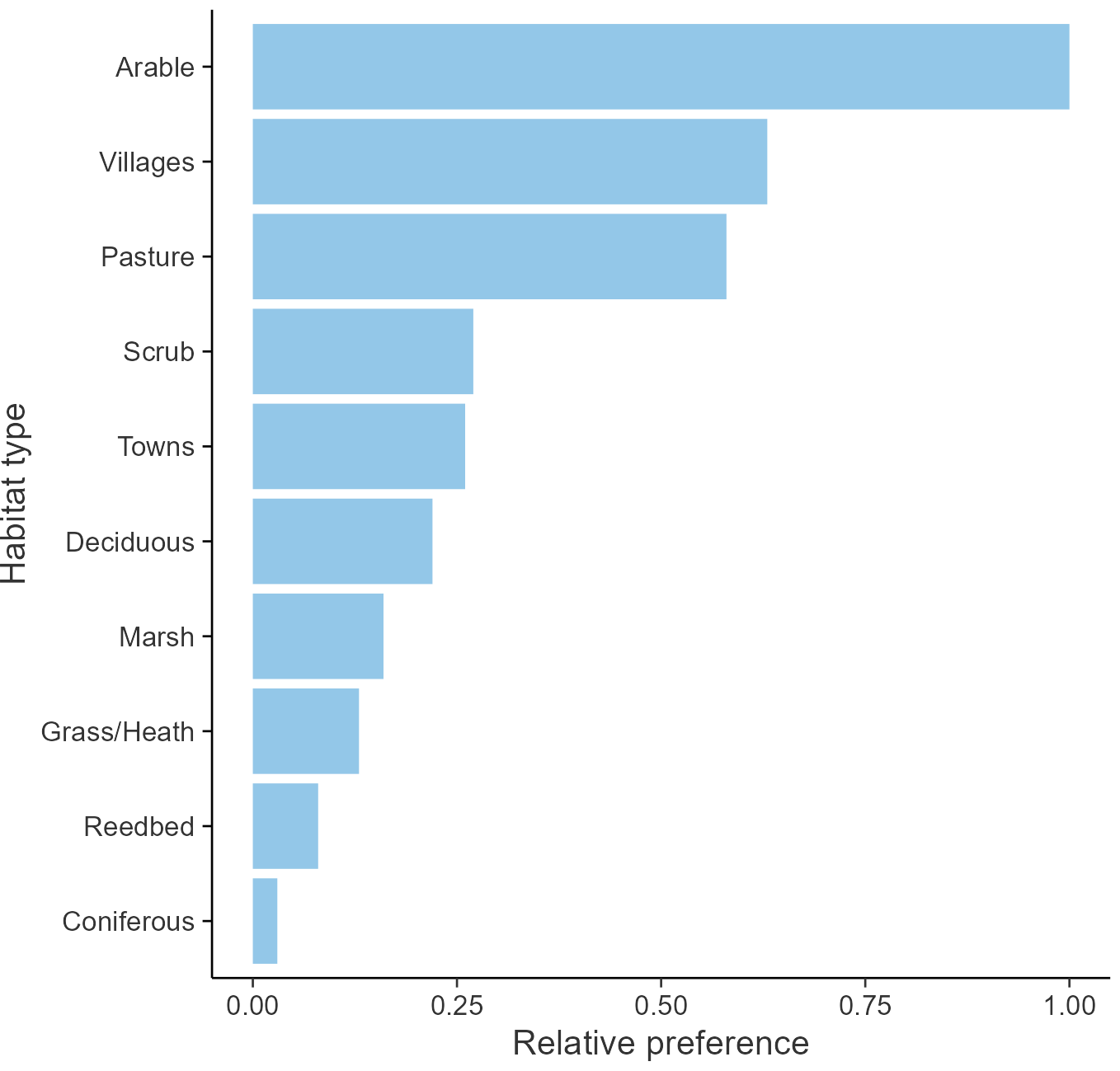
Movement
Britain & Ireland movement
Foreign locations of birds ringed or recovered in Britain & Ireland
Dots show the foreign destinations of birds ringed in Britain & Ireland, and the origins of birds ringed overseas that were subsequently recaptured, resighted or found dead in Britain & Ireland. Dot colours indicate the time of year that the species was present at the location.
- Winter (Nov-Feb)
- Spring (Mar-Apr)
- Summer (May-Jul)
- Autumn (Aug-Oct)

European movements
EuroBirdPortal uses birdwatcher's records, such as those logged in BirdTrack to map the flows of birds as they arrive and depart Europe. See maps for this species here.
The Eurasian-African Migration Atlas shows movements of individual birds ringed or recovered in Europe. See maps for this species here.
Biology
Productivity and Nesting
Nesting timing
Egg measurements
Clutch Size
Incubation
Fledging
Survival and Longevity
Survival is shown as the proportion of birds surviving from one year to the next and is derived from bird ringing data. It can also be used to estimate how long birds typically live.
View number ringed each year in the Online Ringing Report.
Lifespan
Survival of adults
Biometrics
Wing length and body weights are from live birds (source).
Wing length
Body weight
Ring Size
Classification, names and codes
Classification and Codes
- Order: Passeriformes
- Family: Passeridae
- Scientific name: Passer montanus
- Authority: Linnaeus, 1758
- BTO 2-letter code: TS
- BTO 5-letter code: TRESP
- Euring code number: 15980
Alternate species names
- Catalan: pardal xarrec
- Czech: vrabec polní
- Danish: Skovspurv
- Dutch: Ringmus
- Estonian: põldvarblane
- Finnish: pikkuvarpunen
- French: Moineau friquet
- Gaelic: Gealbhonn-nan-craobh
- German: Feldsperling
- Hungarian: mezei veréb
- Icelandic: Trjáspör
- Irish: Gealbhan Crainn
- Italian: Passera mattugia
- Latvian: lauku zvirbulis
- Lithuanian: eurazinis karklažvirblis
- Norwegian: Pilfink
- Polish: mazurek
- Portuguese: pardal-montês
- Slovak: vrabec polný
- Slovenian: poljski vrabec
- Spanish: Gorrión molinero
- Swedish: pilfink
- Welsh: Golfan Mynydd
Research
Causes of Change and Solutions
Causes of change
The mechanisms underlying the decline in this species are largely unknown, although demographic trends suggest that factors operating during the breeding season are not the main driver.
Further information on causes of change
The number of fledglings per breeding attempt has improved substantially as population sizes have decreased (see above), suggesting that decreases in productivity were not responsible for the decline. This has been driven by declines in daily failure rate at both the nest and chick stages and increases in clutch and brood sizes. It is thus more likely that survival has been the critical demographic measure, although ring-recovery analyses have produced equivocal results, perhaps because of small sample sizes (Siriwardena et al. 1998, 2000b).
Components of agricultural intensification, such as reductions in winter stubble, have been implicated in the decline, although direct evidence supporting such ideas is largely incidental. Tree Sparrows aggregate in areas where seed food is available during the winter and they have declined at the same time as other farmland seed-eaters (Siriwardena et al. 1998), providing circumstantial evidence for shortage of food. In winter in Scotland (Hancock & Wilson 2003), the highest densities of Tree Sparrows were recorded in cereal stubble fields (undersown with grass) and weedy brassica fodder crops. These habitats remain relatively seed-rich but have declined in area in the UK (Fuller 2000, Hancock & Wilson 2003). Field & Anderson (2004) also state that anecdotal evidence suggests that many Tree Sparrow colonies are strongly associated with winter seed food sources, and provision of new seed sources is frequently associated with the establishment of new breeding colonies. Although Siriwardena et al. (2007) did not find a significant positive relationship between winter food supply and breeding population trajectory in areas provisioned by RSPB Bird Aid, this may be due to the fact that the BBS trends for this species are increasing; therefore winter food may not currently be limiting, as the remaining populations are in small remnants of suitable habitat and many are subject to active conservation action (e.g. provision of nest boxes). In Northern Ireland, Colhoun et al. (2017) observed an increase in abundance over five years on farms participating in agri-environment schemes, but found no direct positive association with the provision of seed rich habitat or any other specific management options.
During the breeding season, Field & Anderson (2004) found that wetland-edge habitats played a key role in providing invertebrate prey to allow successful chick rearing throughout the long breeding season and suggest that it is possible that large areas of UK farmland that were formerly occupied no longer provide these invertebrate resources, due to the effects of intensification in the late 20th century. In a study in Wiltshire, McHugh et al. (2016a) examined faecal sacs from nestlings and found a higher proportion of seed in their diet in areas with wild bird seed cover planted to provide seed resources in winter. They surmised that this indicated a shortage of insects, which are a more suitable nestling food. In this study, colony size increased but breeding success decreased in areas with wild bird seed cover (McHugh et al. 2017)
Information about conservation actions
The main drivers of change for the Tree Sparrow are uncertain, but it is believed most likely that declines have been caused by changes in survival. Therefore actions and agri-environment policies to increase seed food availability over winter could potentially benefit this species. However, Siriwadena et al. (2007) did not find a significant positive relationship between winter food supply and trends in a UK-wide study, possibly indicating that winter food may not currently be limiting as the remaining populations are in small remnants of suitable habitat and many are already subject to active conservation action (e.g. provision of nest boxes).
Providing overwinter food using wild bird seed cover may also have unintended negative impacts on breeding performance, with nestlings being fed on larger quantities of seed and experiencing reduced fledging success (McHugh et al. 2016a, 2017). This is likely to reflect a shortage of invertebrates and therefore actions to address this shortage may be at least as important in some areas as providing overwinter food. These actions could include using existing agri-environment options to provide habitats which support key invertebrate prey items used by Tree Sparrows during the breeding season (Field et al. 2010). Wetland-edges are a key habitat which help provide invertebrates and hence may help improve Tree Sparrow productivity (Field & Anderson 2004).
Further actions which encourage Tree Sparrows to return to sites from which they have been lost due to agricultural intensification are also likely to be required in order to enable a full recovery to take place. As well as providing nest boxes at sites close to existing populations (e.g. von Post et al. 2015), local conservation actions and agri-environment options will be needed to ensure that invertebrate prey are available at these sites during the breeding season and that seeds are available over winter.
Publications (3)
Drivers of the changing abundance of European birds at two spatial scales
Author: Gregory, R.D., Eaton, M.A., Burfield, I.J., Grice, P.V., Howard, C., Klvaňová, A., Noble, D., Šilarová, E., Staneva, A., Stephens, P.A., Willis, S.G., Woodward, I.D. & Burns, F.
Published: 2023
Understanding how human activities drive biodiversity change at different spatial scales is a key question for conservation practitioners and decision-makers. While we have a good understanding of the primary causes of observed biodiversity declines – which include land-use change, climate change, pollution, and the over-exploitation of species – we still struggle to measure and detect biodiversity change in robust and meaningful ways.
29.05.23
Papers
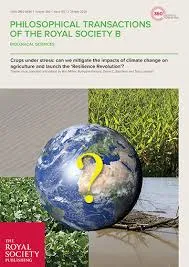
Birds of Conservation Concern Wales 4: the population status of birds in Wales
Author: Johnstone, I.G., Hughes, J., Balmer, D.E., Brenchley, A., Facey, R.J., Lindley, P.J., Noble, D.G. & Taylor, R.C.
Published: 2022
The latest review of the conservation status of birds in Wales. The report assessed all 220 bird species which regularly occur in Wales. There are now 60 species of bird on the Red List, with 91 on the Amber List and just 69 - less than a third of the total number of species - on the Green List. The latest review of the conservation status of birds in Wales comes 20 years after the first, when the Red List was less than half the length it is today. The report assessed all 220 bird species which regularly occur in Wales. There are now 60 species of bird on the Red List in Wales, with 91 on the Amber List and 69 on the Green List. The Birds of Conservation Concern in Wales report assesses the status of each species against a set of objective criteria. Data sources include the BTO/JNCC/RSPB Breeding Bird Survey and the BTO/RSPB/JNCC Wetland Bird Survey, as well as Bird Atlases and other BTO-led monitoring schemes and citizen science initiatives. These are used to quantify the changing status of the species’ Welsh population. The UK, European and global conservation status of the species is also considered, placing the Welsh population into a wider context. The Red ListSwift, Greenfinch and Rook – familiar breeding species in steep decline across the UK – are among the new additions to the Welsh Red List, which now also includes Purple Sandpiper, on account of a rapidly shrinking Welsh wintering population, and Leach’s Petrel, an enigmatic seabird in decline across its global range. These species now sit alongside well-known conservation priorities, such as Curlew, Hen Harrier and Turtle Dove as birds at risk of being lost from Wales for good. Uplands and woodlands Many of the species on the Red List are found in upland and farmland habitats. Starling, Tree Sparrow, Yellow Wagtail and Yellowhammer can no longer be found in much of Wales, while iconic species of mountain and moorland, such as Ring Ouzel, Merlin and Black Grouse, remain in serious trouble. Wales is well known for its populations of woodland birds; however, many of these – including Lesser Spotted Woodpecker, Willow Warbler and Spotted Flycatcher – also feature on the Red List. Goldcrest, which has seen its Welsh population shrink alarmingly in recent decades, is another new addition. On the coast The assessment for Birds of Conservation Concern Wales 4 took place before the impacts of avian influenza could be taken into account. Breeding seabird species have been struggling in Wales for many years, however, and most were already of conservation concern before the outbreak of this disease. Kittiwake, Puffin, Black-headed Gull, and Common, Arctic and Sandwich Tern remain on the Red List. Wales holds internationally significant numbers of breeding seabirds, making the decline of these colonies a global concern. The Amber ListDeclines in Wheatear, Garden Warbler and House Martin - all migrants which breed in Europe and winter in sub-Saharan Africa - mean these species have moved from the Green List to the Amber List. Many other ‘Afro-Palearctic' migrant species are also in decline, but the potential reasons for this, such as habitat loss and reduced availability of invertebrate prey, are not well understood. Closer to home, the declines in the Welsh Chaffinch population, linked to the disease trichomonosis, have seen the species Amber-listed. A number of other species have been placed on the Amber List because of the wider importance of their Welsh populations, which in each case make up more than half the UK total. Wales is home to more than three-quarters of the UK’s Choughs, for example, so recent declines are cause for concern. The nation’s breeding populations of Manx Shearwater, Pied Flycatcher, Goshawk and Hawfinch also account for more than half the UK total, as does its wintering population of Spotted Redshank. It’s not all bad news, though: some species now on the Amber List have moved up from the Red List, indicating some positive change in their population trends. These include Common Sandpiper, Great Black-backed Gull, Bullfinch, Goldcrest and Pied Flycatcher. The Green ListWhile the report contains much cause for alarm, several conservation success stories shine through. Red Kite was almost lost as a British bird during the first half of the 20th century, when only a handful of pairs remained in remote Welsh valleys. Since then, a sustained conservation effort has brought the species back from the brink. Wales is now home to more than 2,500 pairs of Red Kite and the species has now been moved to the Green List, reflecting this incredible change in fortunes. Song Thrush, Reed Bunting, Long-tailed Tit, Redwing and Kingfisher are among the other species to have gone Green, providing much-needed hope that things can go up as well as down.
06.12.22
Reports Birds of Conservation Concern

The State of the UK's Birds 2020
Author: Burns, F., Eaton, M.A., Balmer, D.E., Banks, A., Caldow, R., Donelan, J.L., Douse, A., Duigan, C., Foster, S., Frost, T., Grice, P.V., Hall, C., Hanmer, H.J., Harris, S.J., Johnstone, I., Lindley, P., McCulloch, N., Noble, D.G., Risely, K., Robinson, R.A. & Wotton, S.
Published: 2020
The State of UK’s Birds reports have provided an periodic overview of the status of the UK’s breeding and non-breeding bird species in the UK and its Overseas Territories since 1999. This year’s report highlights the continuing poor fortunes of the UK’s woodland birds, and the huge efforts of BTO volunteers who collect data.
17.12.20
Reports State of the UK's Birds
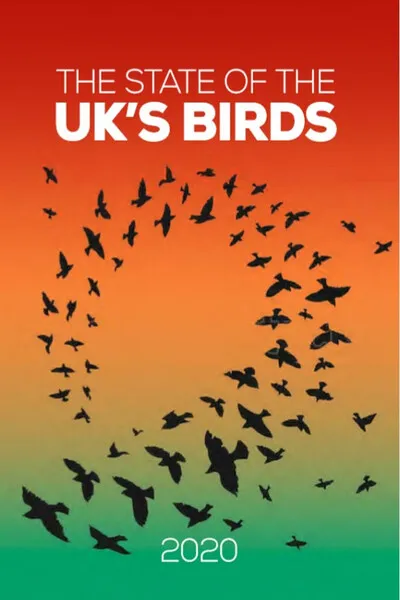
More Evidence
More evidence from Conservation Evidence.com
Partners
Citing BirdFacts
If you wish to cite particular content in this page (e.g. a specific value) it is best to use the original sources as linked in the page. For a more general citation of the whole page please use: BTO (20XX) BirdFacts Species: profiles of birds occurring in the United Kingdom. BTO, Thetford (www.bto.org/birdfacts, accessed on xx/xx/xxxx).

